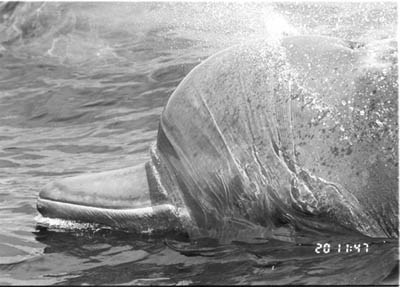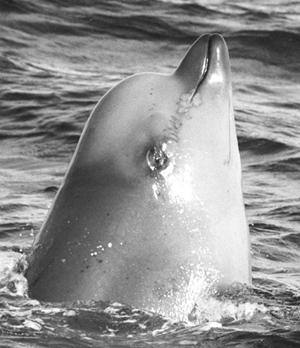Tonya Wimmer
Email: twimmer@dal.ca
Hey there! I just finished my Master's
degree here in the Whitehead Lab at
I am a native of
My love of the ocean and it's inhabitants, particularly the whales and dolphins, brought me to Dal's Marine Biology program in 1995.
I completed my Honours BSc and now my Master's of Biology in the Whitehead Lab.
Have fun exploring these pages. If you'd like, drop me a line :)
Master's Thesis (2001 - 2003)
Distribution of cetaceans on the continental shelf break off
(Hyperoodon ampullatus).
Abstract
Using data collected in 2001 and 2002, I described the distribution and
quantified the movements of northern bottlenose whales (Hyperoodon
ampullatus ) in the waters off northeastern US and southeastern
G-tests and analysis of lagged identification rates suggest that there is
heterogeneity in movement patterns of individuals. While some individuals move
between the three canyons over periods of 1-2 days, others prefer to remain in
a given canyon for longer periods. No differences between sex ratios in the
different canyons were detected; however, there were differences in their
estimated mean residence time within a canyon and emigration rates from a
canyon. Bottlenose whales appear to have very localized movements compared with
described movement patterns for other large pelagic predators. This lack of
movement may be related to their reliance on primarily only one prey genus, Gonatus
spp.
Surveys in 2001 provided the opportunity to examine the distribution of
cetaceans along the 1000 m contour. Cetaceans were visually and acoustically
detected along the entire survey route with a total of 11 species encountered.
Bottlenose whales, Atlantic white-sided (Lagenorhynchus acutus) and
common ( Delphis delphis) dolphins were typically found in areas of high
slope incline while Rissoís dolphins (Grampus griseus) in areas of lower
slope incline. Sei (Balaenoptera borealis) and Mesoplodon spp.
were found primarily in western waters, while bottlenose and pilot (Globicephalus
melas) whales were found in eastern waters. Acoustically, sperm whales (Physeter
macrocephalus) and delphinids were heard along the entire route while
bottlenose whales were only on the eastern Scotian Shelf and off the
Research in 2002 allowed the examination of the distribution of cetaceans in
Shortland and Haldimand canyons, areas for which cetacean distribution was
previously unknown. In 2002, ten species were encountered in Shortland and
Haldimand canyons including bottlenose, blue (Balaenoptera musculus )
and fin (Balaenoptera physalus) whales, Mesoplodon spp. and one
Cuvierís beaked whale (Ziphius cavirostris). Shortland and Haldimand
canyons appear to be important for northern bottlenose whales and likely, for
blue whales. These waters should be given protection from anthropogenic
development.
Educational Background
2001-2003. Master's of Biology.
1995-2000. Honours in Marine Biology Co-op (First-class honours,
minor in statistics).
Scholarships / Awards
2001-2003. NSERC Postgraduate Scholarship (Master's Level)
1999. NSERC Undergraduate Scholarship.
1999.
1998. David Durward Memorial Prize
1998. Ming Fang Li Memorial Prize
1997.
1996.
Other sources of support
2003. Sarah Haney, funding
2003. Helley Hansen
2000. Mountain Equipment Co-op; equipment support
2000. Canada Trust Friends of the Environment; financial support
Publications (non-peer reviewed)
Wimmer, T. 2000. Distribution of cetaceans in St.
Relevant Pratical Experience
Present. Working for Research Casting International to develop a
whale museum for
Present. Research Assistant for Hal Whitehead and DFO-NFLD. Work
includes: completing the photo-id analysis of northern bottlenose whales off
Aug. 2003 & Sept. 2003. Crew and field assistant aboard yacht Balaena on the Scotian Shelf. Work included: photographic, genetic and acoustic sampling of northern bottlenose whales. Project involved lots of sailing and outrunning Hurricane Juan.
May 2001- Sept. 2003. Lead researcher aboard yacht Balaena from Beaufort,North Carolina to Halifax, NS (May 2001-Aug 2001) conducting cetacean surveys on the1,000m contour and studying submarine canyons on the Scotian Shelf (July 2002-August 2002).Work includes: photographic, behavioral and acoustic sampling and lots and lots of sailing.
Dec. 2000 - Feb. 2001. Crew and field assistant aboard the yacht Balaena
from
Jan. 2000 - Nov. 2000. Research Assistant studying sperm whale acoustics for PhD. candidate Luke Rendell at Dalhousie University.Work included: analyzing acoustic recordings of sperm whales (Phystermacrocephalus ).
May - Aug. 2000. Lead researcher testing the feasibility of using
theodolite tracking to assess the impacts of whale-watching on cetaceansin
May - June 2000. Lobster fisher person with the Frasers in
April 2000. Field assistant aboard yacht Balaena studying
sperm whales off
July - Aug. 2000. Field Assistant studying social structure of
long-finned pilot whales in St. Lawrence Bay,
A. Ottensmeyer.Work was conducted aboard a commercial whale-watch and included:
photographic,behavioral and acoustic sampling.
July - Aug. 2000. Naturalist aboard Captain Cox's Whale Watch in
Other Interests / Activities
- Oil and Gas Exploration in
- Member and organizer of the Marine Animal Response Society
(MARS)
Go here for Biology 4060 Class Material
 Mailing Address:
Mailing Address:
Department of Biology
 last updated by me in
November 2003
last updated by me in
November 2003